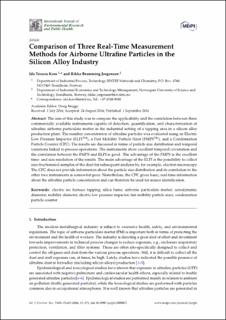| dc.contributor.author | Kero, Ida | |
| dc.contributor.author | Jørgensen, Rikke Bramming | |
| dc.date.accessioned | 2020-11-24T08:16:51Z | |
| dc.date.available | 2020-11-24T08:16:51Z | |
| dc.date.created | 2016-09-05T14:45:00Z | |
| dc.date.issued | 2016 | |
| dc.identifier.citation | International Journal of Environmental Research and Public Health. 2016, 13 (9), . | en_US |
| dc.identifier.issn | 1660-4601 | |
| dc.identifier.uri | https://hdl.handle.net/11250/2689207 | |
| dc.description.abstract | The aim of this study was to compare the applicability and the correlation between three commercially available instruments capable of detection, quantification, and characterization of ultrafine airborne particulate matter in the industrial setting of a tapping area in a silicon alloy production plant. The number concentration of ultrafine particles was evaluated using an Electric Low Pressure Impactor (ELPITM), a Fast Mobility Particle Sizer (FMPSTM), and a Condensation Particle Counter (CPC). The results are discussed in terms of particle size distribution and temporal variations linked to process operations. The instruments show excellent temporal covariation and the correlation between the FMPS and ELPI is good. The advantage of the FMPS is the excellent time- and size resolution of the results. The main advantage of the ELPI is the possibility to collect size-fractionated samples of the dust for subsequent analysis by, for example, electron microscopy. The CPC does not provide information about the particle size distribution and its correlation to the other two instruments is somewhat poor. Nonetheless, the CPC gives basic, real-time information about the ultrafine particle concentration and can therefore be used for source identification. | en_US |
| dc.language.iso | eng | en_US |
| dc.publisher | MDPI | en_US |
| dc.rights | Navngivelse 4.0 Internasjonal | * |
| dc.rights.uri | http://creativecommons.org/licenses/by/4.0/deed.no | * |
| dc.subject | condensation particle counter | en_US |
| dc.subject | fast mobility particle sizer | en_US |
| dc.subject | electric low pressure impactor | en_US |
| dc.subject | mobility diameter | en_US |
| dc.subject | aerodynamic diameter | en_US |
| dc.subject | airborne particulate matter | en_US |
| dc.subject | silica fume | en_US |
| dc.subject | electric arc furnace tapping | en_US |
| dc.title | Comparison of Three Real-Time Measurement Methods for Airborne Ultrafine Particles in the Silicon Alloy Industry | en_US |
| dc.type | Peer reviewed | en_US |
| dc.type | Journal article | en_US |
| dc.description.version | publishedVersion | en_US |
| dc.rights.holder | © 2016 by the authors; licensee MDPI, Basel, Switzerland. This article is an open access article distributed under the terms and conditions of the Creative Commons Attribution (CC-BY) license (http://creativecommons.org/licenses/by/4.0/). | en_US |
| dc.source.pagenumber | 14 | en_US |
| dc.source.volume | 13 | en_US |
| dc.source.journal | International Journal of Environmental Research and Public Health | en_US |
| dc.source.issue | 9 | en_US |
| dc.identifier.doi | 10.3390/ijerph13090871 | |
| dc.identifier.cristin | 1378253 | |
| dc.source.articlenumber | 871 | en_US |
| cristin.ispublished | true | |
| cristin.fulltext | original | |
| cristin.qualitycode | 1 | |

